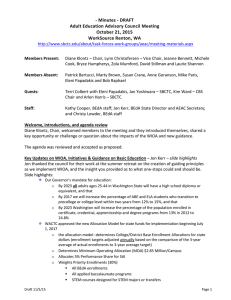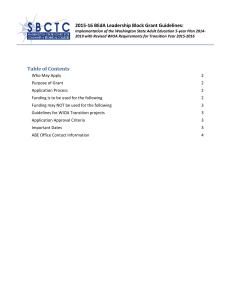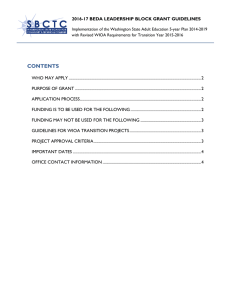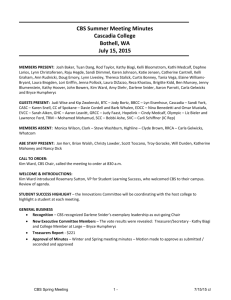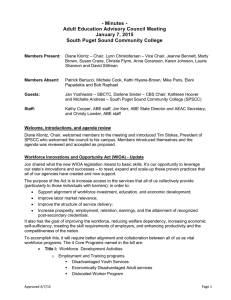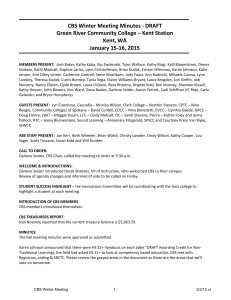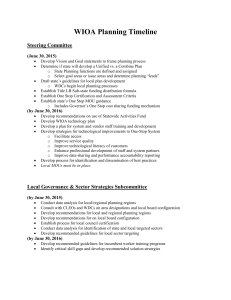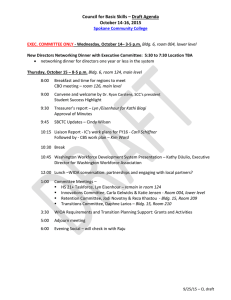CBS Fall Meeting Minutes Spokane Community College Spokane, WA October 15-16, 2015
advertisement
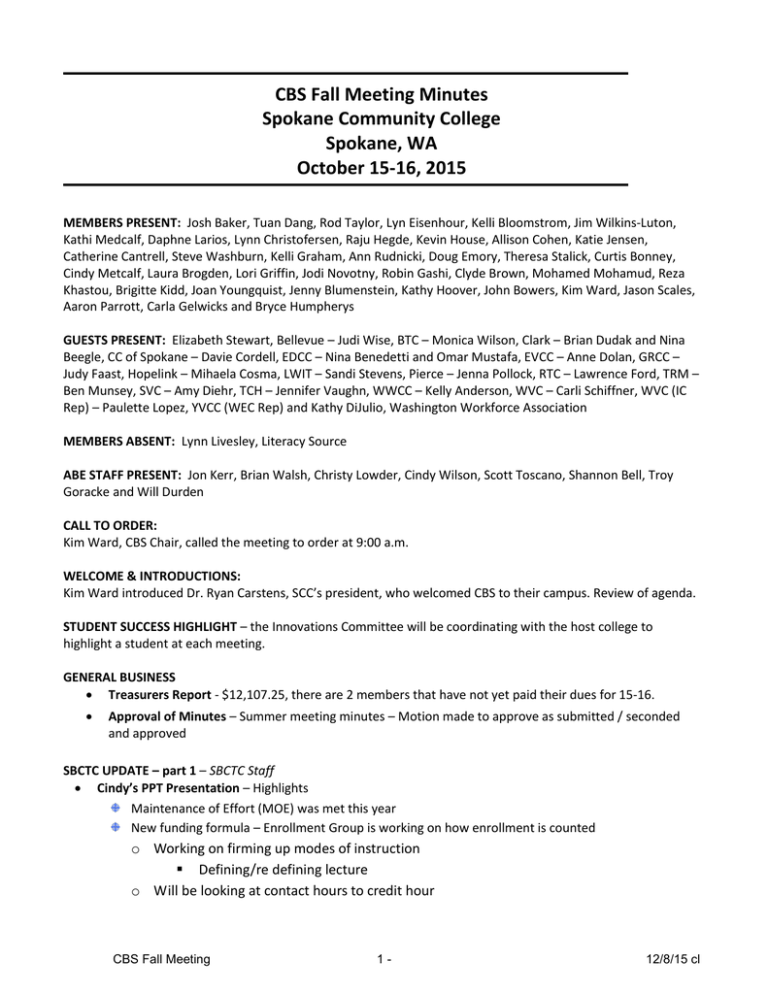
CBS Fall Meeting Minutes Spokane Community College Spokane, WA October 15-16, 2015 MEMBERS PRESENT: Josh Baker, Tuan Dang, Rod Taylor, Lyn Eisenhour, Kelli Bloomstrom, Jim Wilkins-Luton, Kathi Medcalf, Daphne Larios, Lynn Christofersen, Raju Hegde, Kevin House, Allison Cohen, Katie Jensen, Catherine Cantrell, Steve Washburn, Kelli Graham, Ann Rudnicki, Doug Emory, Theresa Stalick, Curtis Bonney, Cindy Metcalf, Laura Brogden, Lori Griffin, Jodi Novotny, Robin Gashi, Clyde Brown, Mohamed Mohamud, Reza Khastou, Brigitte Kidd, Joan Youngquist, Jenny Blumenstein, Kathy Hoover, John Bowers, Kim Ward, Jason Scales, Aaron Parrott, Carla Gelwicks and Bryce Humpherys GUESTS PRESENT: Elizabeth Stewart, Bellevue – Judi Wise, BTC – Monica Wilson, Clark – Brian Dudak and Nina Beegle, CC of Spokane – Davie Cordell, EDCC – Nina Benedetti and Omar Mustafa, EVCC – Anne Dolan, GRCC – Judy Faast, Hopelink – Mihaela Cosma, LWIT – Sandi Stevens, Pierce – Jenna Pollock, RTC – Lawrence Ford, TRM – Ben Munsey, SVC – Amy Diehr, TCH – Jennifer Vaughn, WWCC – Kelly Anderson, WVC – Carli Schiffner, WVC (IC Rep) – Paulette Lopez, YVCC (WEC Rep) and Kathy DiJulio, Washington Workforce Association MEMBERS ABSENT: Lynn Livesley, Literacy Source ABE STAFF PRESENT: Jon Kerr, Brian Walsh, Christy Lowder, Cindy Wilson, Scott Toscano, Shannon Bell, Troy Goracke and Will Durden CALL TO ORDER: Kim Ward, CBS Chair, called the meeting to order at 9:00 a.m. WELCOME & INTRODUCTIONS: Kim Ward introduced Dr. Ryan Carstens, SCC’s president, who welcomed CBS to their campus. Review of agenda. STUDENT SUCCESS HIGHLIGHT – the Innovations Committee will be coordinating with the host college to highlight a student at each meeting. GENERAL BUSINESS Treasurers Report - $12,107.25, there are 2 members that have not yet paid their dues for 15-16. Approval of Minutes – Summer meeting minutes – Motion made to approve as submitted / seconded and approved SBCTC UPDATE – part 1 – SBCTC Staff Cindy’s PPT Presentation – Highlights Maintenance of Effort (MOE) was met this year New funding formula – Enrollment Group is working on how enrollment is counted o Working on firming up modes of instruction Defining/re defining lecture o Will be looking at contact hours to credit hour CBS Fall Meeting 1- 12/8/15 cl o A report will be out Winter quarter o Goes to the presidents group in Spring quarter o Board approval at summer meeting Fiscal reminders from the budget office: o 10/31/15 first quarterly invoices are due o Time and effort A position funded in whole or part by federal funding must be complete time and effort If in an audit finding results in inaccurate T&E they risk not getting any federal funding and you will have to send your T&E in for 3mos. To demonstrate that you have gotten this down. See time and effort guidelines for questions contact Michele Rockwell, mrockwell@sbctc.edu Update on the creation of ESL CCR standards initiative: o The JFF proposal was NOT selected, which we (SBCTC) were partnered with o The AIR with TESOL proposal WAS selected o Promote high levels of content and language learning among adult ELLs. We asked if this would mean they got ELL student to college level and math --- YES o Looks like if they are not aligned then….possible revision of EFL descriptors Troy’s PPT Presentation – Highlights CCRS Trainings – we have two trainings: o CCRS 101 – intro to CCRS, training done by request o CCRS Rubric – focuses on assessment & contextualized instruction (requires some knowledge of CCRS) Bridges to College Transition Project – this can be helpful for those with Compass going away I-BEST - I-BEST Digest Training Update 1-pager Rendezvous 2016 feedback due 10.30.15 IC LIAISON REPORT – Carli Schiffner IC Work Plan 15-16 with CBS assignments Instruction Commission Work Plan – highlighted the crosswalk items o Goal 2: Student Success – Providing Access, Retention, and Articulation Initiatives 2.1 Increase student access and success 2.2 Explore learning options that hold student competencies as a fixed factor and time as a variable factor in learning 2.3 Increase transitions for students: o o From basic skills to college level Goal 3: Innovation – Planning, Developing, and Implementing Innovation Strategies, including Technology 3.1 Improve the ability of colleges to develop a culture of evidence to drive institutional decision making Goal 4: Equity – Close Equity Gaps for All Students 4.1 Increase participation and success of underrepresented populations in workforce and transfer pathways CBS Fall Meeting 2- 12/8/15 cl Discussion on next steps as COMPAS placement exam sunsets Discussion on Smarter Balanced assessment and crosswalk from high school Enrollment / Coding – workgroup working on defining enrollment counting for the system to support the new allocation formula CTC Link and preparing for transition Discussion on prior learning assessment – Military experience crosswalk and December deadline Work continues on the BAS committee – working on infrastructure on how to develop applied baccalaureate degrees Discussion continues on competency based degrees CBS WORKPLAN – Kim Ward - CBS draft workplan 2015-16 WASHINTON WORKFORCE DEVELOPMENT SYSTEM PRESENTATION – Kathy DiJulio - WWA presentation Kathy shared a system overview of the WWA and let the council members know that the WDC’s want to spend more time with their new core program partners and you are one of them! Q and A section: 1) Are the WFBs concerned that 75% of the out-of-school youth have to be? No, they’ve been planning for it and are more concerned for GED® & family education programs. 2) Can you explain the difference between Wagner-Peyser and unemployment compensation? Wagner-Peyser (labor exchange) is a supporting program located in the community that helps find people jobs – job finding assistance for those on unemployment – has always been part of the One-stops. Unemployment Compensation is the program that makes sure that people receive their unemployment benefits. 3) How are the services provided & who provides those services? Have to meet federal procurement standards/administrative structure. Ability to provide those management services; does not matter whether your organization is a private or non-profit. Guidance for this is all laid out in the competitive bid. 4) Integration through technology, what are they looking for? They want people to access the one-stop either virtually or physical location. 5) What’s the difference between One-stop Center and partners and One-stop Operators? One-stop is the physical location and the 4 core programs are to be offered there Title 1, 2, 3 and 4. 6) What are some promising partnerships you’ve seen over the years? At the local levels, there are many good partnerships; it comes down to the people & personalities. It really comes down to the money and how they talk to one another and how they problem solve together. Worker Retraining is an example of a program working well. She’ll ask Eric to get some good basic skills examples and get those back to you. 7) CBO partnering – where do WDCs post their procurement opportunities? They post the opportunities to their individual websites. 8) Wagner-Peyser service, how are they different from the WorkSource? It’s different as it’s a funding source, the services are the same and is what is offered at the WorkSource and the staff represents all titles of the One-stop, not just one title. Some One-stops are down-sizing now CBS Fall Meeting 3- 12/8/15 cl 9) Had understood that the comprehensive centers were where the core partners need to be, rather than the affiliate sites/connection sites…..she heard you say that this was more the region, where do we need to be providing services? (Jodi’s part of the One-stop taskforce) Region is a labor market development area, where the jobs are and who shares some common industries…is a service in the highest level, but not a direct service to a client (like a taskforce). What you said is correct for the local area. One-stop center is a must for where core programs are to be. You may also be located in any affiliate center…you have flexibility. 10) What about not having SSNs and serving those folks? Yes, they can be serviced, but the Skyes program does not have the flexibility to enroll them without a SSN so they won’t count for your statistics. Skyes cannot take the pseudo SSN that our system creates. Skyes will be developing some type of crosswalk with the UI record (ESD) and their record. She’ll check and get back with us. 11) What’s a UI Record? It’s Unemployment Insurance record – ESD uses this number 12) Key strategies to improve services to individuals with disabilities…could you tell us about the current service level? How we as a system can access? About 5% of DVR come through the One-stops; we need to strengthen our assessment. 13) It is my understanding that the performance (new) measure for adults will not include secondary credentials only postsecondary credentials? New question for Kathy Jon’s recollection is that HSD and GED® will count only if a student transitions to postsecondary education or gets employed within a year of exit. WIOA TRANSITIONS GRANT ACTIVITY – Kim Ward Go to the CBS CAVAS site to see this discussion COMMITTEE REPORT OUTS: High School 21+ Task Force – Lyn Eisenhour o College/CBO partnership – sharing MOU (Sound Learning/SPSCC) o Open Doors partnership – can leverage contextualized adult high school courses to serve more students. Consider beginning an application process/planning now if interested in applying for the upcoming year. o Curriculum repository – submit to Troy o Goal/CBS work plan – two key focus areas: marketing and alignment….marketing for HS 21+ and the exit criteria for English and Math Innovations Committee – Carla Gelwicks & Katie Jensen o Sharing info on innovations – get information out in CANVAS o Math infused curriculums o Promising practices at Winter mtg – Ignite SPSCC’s Career Pathways demonstration Spokane CC’s intro to manufacturing and apprenticeship and business partnerships Concurrent sessions of Ignite at Rendezvous o Sub-committee to research short certificate credentials that could be embedded into basic skills curriculum o Asked SBCTC to investigate ways for them to distribute promising practices, grant projects, grantfunded curriculum development to every provider in the state Retention – Jodi Novotny & Reza Khastou CBS Fall Meeting 4- 12/8/15 cl o 16-17 Assessment Policy – improve federal performance targets (real impact on 17-18 once we know WIOA regs.) o Discussed system-wide unhappiness with CASAS assessment instruments, the committee wants to strategize for choosing another standardized assessment instrument for the 2017-18 Assessment Policy Transitions – Daphne Larios o Ability to Benefit 1-pager – will be developed to describe the various ways a student may qualify for Ability to Benefit o Myths about transition from ABE – first one page myths and solutions will be sent out to CBS after the Friday meeting. CBO meeting update – Ann Rudnicki o Each person gave a report on what his or her organization is doing as part of the WIOA Transition project. There were three prime themes: alignment of CCRS & Curriculum; work on Employability skills & pathways, and Transitions specific projects o Sound Learning is piloting a CBO HS 21 course this term, and other CBOs are interested in finding a way to participate in HS 21+ o Collaboration is a critical part of CBO philosophy as well as of many of the WIOA mandates. CBOs continue to ask that the SAI structure be adjusted to better accommodate collaborative efforts, so that CBOs (and colleges as well) can be appropriately compensated through the outcomes based funding mechanism for their work with students. SBCTC UPDATE – part 2 – SBCTC Staff SBCTC Responsibilities – Shannon Bell is our new WABERS+ helpdesk person!! BEdA Staff Responsibilities Jon’s PPT Presentation – Highlights - BEdA Presentation, 10.2.15 Our Governor’s mandate for education: o By 2023 all adults ages 25-44 in Washington State will have a high school diploma or equivalent, and that o By 2017 we will increase the percentage of ABE and ELA students who transition to precollege or college level within two years from 12% to 15%, and that o By 2023 Washington will increase the percentage of the population enrolled in certificate, credential, apprenticeship and degree programs from 13% in 2012 to 24.8% WACTC approved the new Allocation Model for state funds for implementation beginning July 1, 2017 o the allocation model--determines College/District Base Enrollment Allocations for state dollars (enrollment targets adjusted annually based on the comparison of the 3-year average of actual enrollments to 3-year average target) o Determines Minimum Operating Allocation (MOA) $2.85 Million/Campus o Allocates 5% Performance Share for SAI o Weights Priority Enrollments (30%) All BEdA enrollments All applied baccalaureate programs STEM courses designed for STEM majors or transfers Workforce high demand courses identified as contributing to degrees needed to meet skills gaps identified in the Joint Study on A Skilled and Educated Workforce o This means an approximately $1,000/FTE increase for basic skills enrollments The Ability to Benefit option for federal financial aid---it allows students who are co-enrolled in basic skills and college-level career pathway programs--- who do not have a HSD or GED®--- to test CBS Fall Meeting 5- 12/8/15 cl at a certain level or earn 6 college level credits successfully and if eligible move onto federal financial aid. This means that all of our prof. technical I-BEST programs are Ability to Benefit eligible and Academic I-BEST is eligible as a career pathway under Ability to Benefit as long as students are co-enrolled in basic skills and college-level programming with the goal of earning a transfer degree. This is something you need to let your financial aid folks know. That means all of our I-BEST programs are eligible for Ability to Benefit as long as students remained co-enrolled. Also, remember that the Opportunity grant and State need grant can be used to fund that first quarter to allow students without a HSD or GED® to earn the credits needed to move on to Ability to Benefit in their second quarter. WIOA reminders and updates: WIOA Strategic Plan Draft Timeline & Partner Expectations o Basic skills is now defined as academic instruction and education services below the postsecondary level that increases: Reading, writing, speaking, listening, mathematics, English acquisition, technology and employability skills for attainment of a secondary school diploma or its equivalent Transition to postsecondary education and training Obtain employment o The 1st draft of the WIOA state plan is being drafted by the WTECB and will be available for input August 25 Writing team began weekly meetings-based on input from the team the WFB drafted an outline detailing the sections of the plan September 17-WFB took action on plan outline September/October-public forums for input November 19, draft plan to WFB for approval November-January, the draft plan will be posted for public comment. We will be working with all of you on input. January-present draft plan to legislative Committees as FYI February WFB approves final plan and submits it to the Governor March 1, 2016 plan submitted to US DOL & DOE o 2016-17 Extension or RFA??? AEFLA Procurement Readiness We believe that OCTAE has listened to us and is considering letting us run an extension for FY17 vs. a full blown competitive RFA. If an extension is approved, the process will be similar to last year’s application – however, all current providers will be required to have ALL elements of WIOA implemented by July 1, 2017. RFA/extension awardees begin full implementation of WIOA Joint funding for One-stops begins EL Civics changes are implemented Common performance measures kick in Key dates: February 11, 2016 Extension/RFA Grant Application Opens March 24, 2016 - 11:55PM Grants Due WIOA Local Areas, Regions & One-stops WIOA Regions Map o Currently in Washington, there are two very different opinions of how this should be set up in our state: WDCs-local areas & Local Elected Officials - recommend that the current 12 WDC local areas are named as WIOA Regions CBS Fall Meeting 6- 12/8/15 cl Workforce Training and Education Coordinating Board & WIOA Taskforce - Recommends only 6 WIOA Planning Regions It’s yet to be determined which one of these will be selected, if you have any input, submit your comments by the end of the day Monday, October 18. DOL’s Vision for One-Stops – “The National Vision is that One-Stops are not just Workforce anymore but an integrated service that is shared. One-stops should not be a referral system but can actually serve individuals in the location they enter.” Robert Knight, DOL o One-stops must be an integrated system that leverages resources o Has integrated management systems o Workforce side is funded to provide jobs skills training o And that everyone who walks into the One-Stop needs to be counted and put into the system Update on Funding One-Stops 10.2.15 o clarification on the two options under WIOA The first is the local option where the local board, chief elected officials, and one-stop partners may fund the costs of the infrastructure of one-stop centers in a local area. Funding and in-kind support are described in the MOU. At this level there is not cap and occurs through consensus. The second is the state option. If an agreement fails to be reached the Governor decides on funding (money only) and this is where the 1.5 cap is implemented. This is a great resource to all guidance that has been sent out by DOL and DOE WIOA Resources 1pager WIOA Exit Definition Youth Re-engagement o Title 1 funds for Out of School Youth (OSY) were increased from 35% of youth funding to 75%. Currently there are opposing interpretations of what are considered OSY o WIOA describes all basic skills students (our students) as OSY if under 24 years of age. That means those funds must be used to provide services to our students basic skills programming. We support ABE students as OSY. We do not support students in HS re-engagement programs as OSY. This is where we are in conflict with the WFB and OSPI. We have 3 concerns:o ABE students funded at 2,300 per FTE—K-12 funded at 6,300 FTE o OSPI & WFB want to include only re-engagement students going for a GED. It pushes students to a GED rather than a HSD. o DOL has guided us not to do this as K-12 students have access to funds our students don’t have access to. We do not want to get into a payback situation. We will support the final regulation. CTC’s two Pathway Initiatives o College Spark – Guided Pathways o Gates Foundation – Student Success Centers Guided Pathway Initiatives As you work with your local WDC area to develop one-stops and your region to establish alignment of you Extension with the local plan, you will want to be sure you know the industry sectors identified as key in your region and design your pathways to align. Our basic skills guided pathways need to align to the sectors in your regional plan. CCRC defines a guided pathway as: The guided pathways approach presents courses in the context of highly structured, educationally coherent program maps. The Guided Pathway Funded – slide 28 When students are ready, most often at Level 4 ABE and Level 5 ESL, they can move into Quarter 1 of I-BEST or other college programming (2nd arrow) with tuition funded by Opportunity Grant and/or CBS Fall Meeting 7- 12/8/15 cl State need grant if they don’t have a HSD or GED®--to earn the 6 credits needed to transition on to Ability to benefit and federal financial aid in their second quarter of I-BEST. Then beginning in their second quarter in I-BEST or other college programming (3rd arrow) they can move onto federal financial aid with Ability to Benefit if they don’t have a HSD or GED® and continue to access, Opportunity Grant, and State Need Grant funding to get them all the way to their two year degree. Upon receiving a 2-year degree in Washington, they can check a box and receive their high school diploma. They then can use those same funding sources to transfer to a 4 year university if they choose. WIOA CHANGES – IMPLICATIONS & STRATEGIES – Executive Committee members Local WDC Partnerships – Jodi Novotny o TCC, TCH and CPTC – the Pierce County WDC partnership really does not have any idea about how we have common clients between the WDC/CTC/CBO Strategies for serving out-of-school youth – Bryce Humpherys o Work place types of activities, one credit of occupational credit o $25 for ABE credit putting in place a pre-requirement for math class next course/work more smoothly MOU’s – Achieving and tracking performance measures – Carla Gelwicks ANNOUNCEMENTS / Q and A time -What’s the potential impact on ESL transitions to college level if we CASAS math test all ESL students? This could sort many students into the ABE count. OCTAE, are you going to give us ESL math to register for? NO NRS guidance is to appraise ESL in math, but do not place them federally by it, place them still federally by their lowest score. SBCTC needs to look into scenario based programming for WABERS+ and will provide guidance to the field. -How will WIOA funds for BEdA be distributed? Federal funds will be allotted to BEdA programs per the allocation model in the state plan (50% enrollment and 50% performance). Funding to One-stops will be described in local MOUs and be handled by providers. Funding for One-stops is described in the following document: http://sbctc.edu/college/abe/6UpdateonFundingofOne-stops.docx -Does the fact that BEdA students generate enhanced FTE (at 1.3:1) and bonus SAI points outweigh the loss of full tuition paid by students in developmental education? In other words, is it worth considering ending dev.ed. and enrolling all precollege students in BEdA or I-BEST? The student doesn’t generate any extra or enhanced FTE. They still get counted as they always have. The application of weighting will be an increase in funding that is applied to the share of the district’s enrollment allocation base (DEAB) that is anticipated to be BEdA or other priority enrollment. The share of the target that is prioritized and therefore weighted will be the % of the district’s BEdA enrollment level (and other priority) when compared to their total enrollments from the most recently completed academic year. Most likely the new allocation model for BEdA will not outweigh the loss of full tuition paid by other students. The extra funding from weighting (which is about $900 per FTE) and the extra points in performance that move more SAI funding won’t make up for the average of $3,800 in full time tuition a FT BEdA student is not required to pay. -Civics funding change – does it have to be a co-enrolled program or not? At this point the guidance from OCTAE has been yes but this will be clarified and could change once final regulations are published. CBS Fall Meeting 8- 12/8/15 cl SYNTHESIS OF KEY POINTS: Catherine Cantrell summarized the key action items. Keep tabs on the quarterly invoices. They are due on 10/31/15 Track time and effort for anything connected to the federal grants including match. Contact Michelle Rockwell at SBCTC if you have questions. Review the BEdA training schedule included in the CBS Handouts Feedback for Rendezvous 2016 concurrent sessions due to Troy by 10/30 Note the new dates for DPI workshops (reduced to one-day sessions) Contact Troy if you have resources for or expertise in transcript evaluation for HS21+ and can be a part of the upcoming Collaborate workshop. Put these dates on your calendar: Feb 11-application for federal grants open; March 24 federal grant applications are due. ADJOURNMENT: The meeting was adjourned at 11:35 a.m. Meeting schedule for 2015-16 Winter meeting – February 3-5, 2016 at Pierce College, Ft. Steilacoom Spring meeting – April 20-22, 2016 at Columbia Basin College Summer meeting – July 28-29, 2016 at Yakima Valley Community College CBS Fall Meeting 9- 12/8/15 cl
